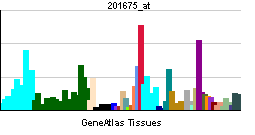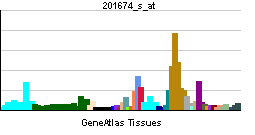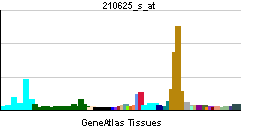AKAP1
| A kinase (PRKA) anchor protein 1 | |||||||||
|---|---|---|---|---|---|---|---|---|---|
| Identifiers | |||||||||
| Symbols | AKAP1 ; AKAP; AKAP121; AKAP149; AKAP84; D-AKAP1; MGC1807; PRKA1; SAKAP84 | ||||||||
| External IDs | Template:OMIM5 Template:MGI HomoloGene: 31165 | ||||||||
| |||||||||
| RNA expression pattern | |||||||||
 | |||||||||
 | |||||||||
 | |||||||||
| More reference expression data | |||||||||
| Orthologs | |||||||||
| Template:GNF Ortholog box | |||||||||
| Species | Human | Mouse | |||||||
| Entrez | n/a | n/a | |||||||
| Ensembl | n/a | n/a | |||||||
| UniProt | n/a | n/a | |||||||
| RefSeq (mRNA) | n/a | n/a | |||||||
| RefSeq (protein) | n/a | n/a | |||||||
| Location (UCSC) | n/a | n/a | |||||||
| PubMed search | n/a | n/a | |||||||
A kinase (PRKA) anchor protein 1, also known as AKAP1, is a human gene.[1]
The A-kinase anchor proteins (AKAPs) are a group of structurally diverse proteins, which have the common function of binding to the regulatory subunit of protein kinase A (PKA) and confining the holoenzyme to discrete locations within the cell. This gene encodes a member of the AKAP family. The encoded protein binds to type I and type II regulatory subunits of PKA and anchors them to the mitochondrion. This protein is speculated to be involved in the cAMP-dependent signal transduction pathway and in directing RNA to a specific cellular compartment.[1]
References
Further reading
- Lester LB, Scott JD (1997). "Anchoring and scaffold proteins for kinases and phosphatases". Recent Prog. Horm. Res. 52: 409–29, discussion 429-30. PMID 9238861.
- Michel JJ, Scott JD (2002). "AKAP mediated signal transduction". Annu. Rev. Pharmacol. Toxicol. 42: 235–57. doi:10.1146/annurev.pharmtox.42.083101.135801. PMID 11807172.
- Lin RY, Moss SB, Rubin CS (1996). "Characterization of S-AKAP84, a novel developmentally regulated A kinase anchor protein of male germ cells". J. Biol. Chem. 270 (46): 27804–11. PMID 7499250.
- Trendelenburg G, Hummel M, Riecken EO, Hanski C (1996). "Molecular characterization of AKAP149, a novel A kinase anchor protein with a KH domain". Biochem. Biophys. Res. Commun. 225 (1): 313–9. doi:10.1006/bbrc.1996.1172. PMID 8769136.
- Huang LJ, Durick K, Weiner JA; et al. (1997). "Identification of a novel protein kinase A anchoring protein that binds both type I and type II regulatory subunits". J. Biol. Chem. 272 (12): 8057–64. PMID 9065479.
- Huang LJ, Wang L, Ma Y; et al. (1999). "NH2-Terminal targeting motifs direct dual specificity A-kinase-anchoring protein 1 (D-AKAP1) to either mitochondria or endoplasmic reticulum". J. Cell Biol. 145 (5): 951–9. PMID 10352013.
- Herberg FW, Maleszka A, Eide T; et al. (2000). "Analysis of A-kinase anchoring protein (AKAP) interaction with protein kinase A (PKA) regulatory subunits: PKA isoform specificity in AKAP binding". J. Mol. Biol. 298 (2): 329–39. doi:10.1006/jmbi.2000.3662. PMID 10764601.
- Steen RL, Martins SB, Taskén K, Collas P (2000). "Recruitment of protein phosphatase 1 to the nuclear envelope by A-kinase anchoring protein AKAP149 is a prerequisite for nuclear lamina assembly". J. Cell Biol. 150 (6): 1251–62. PMID 10995432.
- Furusawa M, Ohnishi T, Taira T; et al. (2001). "AMY-1, a c-Myc-binding protein, is localized in the mitochondria of sperm by association with S-AKAP84, an anchor protein of cAMP-dependent protein kinase". J. Biol. Chem. 276 (39): 36647–51. doi:10.1074/jbc.M103885200. PMID 11483602.
- Razani B, Lisanti MP (2001). "Two distinct caveolin-1 domains mediate the functional interaction of caveolin-1 with protein kinase A.". Am. J. Physiol., Cell Physiol. 281 (4): C1241–50. PMID 11546661.
- Yukitake H, Furusawa M, Taira T; et al. (2003). "AAT-1, a novel testis-specific AMY-1-binding protein, forms a quaternary complex with AMY-1, A-kinase anchor protein 84, and a regulatory subunit of cAMP-dependent protein kinase and is phosphorylated by its kinase". J. Biol. Chem. 277 (47): 45480–92. doi:10.1074/jbc.M206201200. PMID 12223483.
- Furusawa M, Taira T, Iguchi-Ariga SM, Ariga H (2003). "AMY-1 interacts with S-AKAP84 and AKAP95 in the cytoplasm and the nucleus, respectively, and inhibits cAMP-dependent protein kinase activity by preventing binding of its catalytic subunit to A-kinase-anchoring protein (AKAP) complex". J. Biol. Chem. 277 (52): 50885–92. doi:10.1074/jbc.M206387200. PMID 12414807.
- Strausberg RL, Feingold EA, Grouse LH; et al. (2003). "Generation and initial analysis of more than 15,000 full-length human and mouse cDNA sequences". Proc. Natl. Acad. Sci. U.S.A. 99 (26): 16899–903. doi:10.1073/pnas.242603899. PMID 12477932.
- Carlson CR, Ruppelt A, Taskén K (2003). "A kinase anchoring protein (AKAP) interaction and dimerization of the RIalpha and RIbeta regulatory subunits of protein kinase a in vivo by the yeast two hybrid system". J. Mol. Biol. 327 (3): 609–18. PMID 12634056.
- Steen RL, Beullens M, Landsverk HB; et al. (2004). "AKAP149 is a novel PP1 specifier required to maintain nuclear envelope integrity in G1 phase". J. Cell. Sci. 116 (Pt 11): 2237–46. doi:10.1242/jcs.00432. PMID 12697839.
- Hillman RT, Green RE, Brenner SE (2005). "An unappreciated role for RNA surveillance". Genome Biol. 5 (2): R8. doi:10.1186/gb-2004-5-2-r8. PMID 14759258.
- Cardone L, Carlucci A, Affaitati A; et al. (2004). "Mitochondrial AKAP121 binds and targets protein tyrosine phosphatase D1, a novel positive regulator of src signaling". Mol. Cell. Biol. 24 (11): 4613–26. doi:10.1128/MCB.24.11.4613-4626.2004. PMID 15143158.
- Beausoleil SA, Jedrychowski M, Schwartz D; et al. (2004). "Large-scale characterization of HeLa cell nuclear phosphoproteins". Proc. Natl. Acad. Sci. U.S.A. 101 (33): 12130–5. doi:10.1073/pnas.0404720101. PMID 15302935.
| This protein-related article is a stub. You can help Wikipedia by expanding it. |